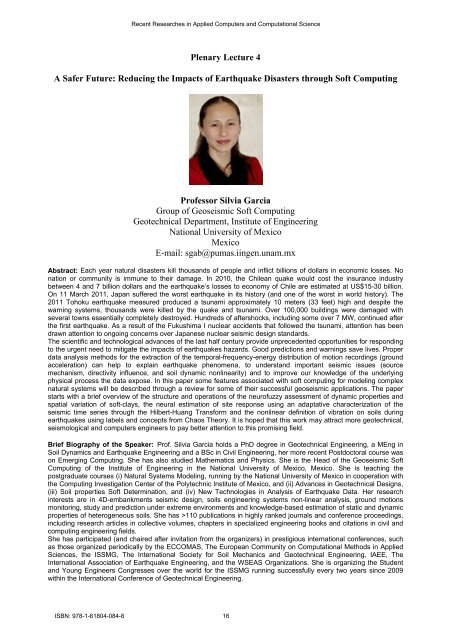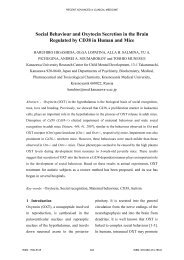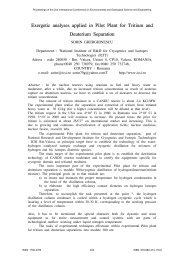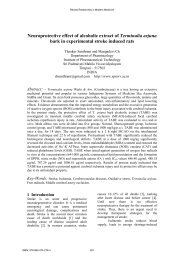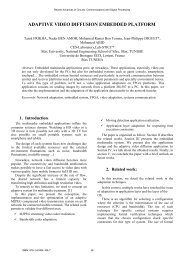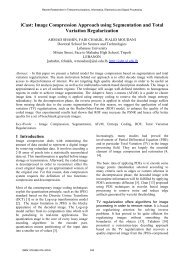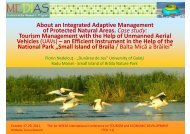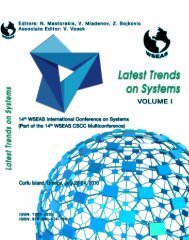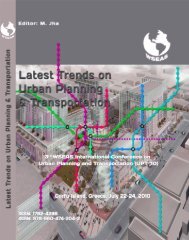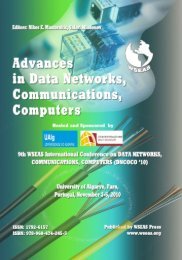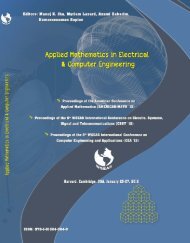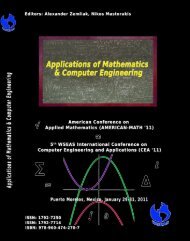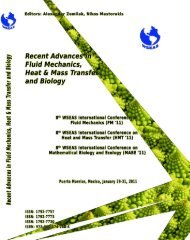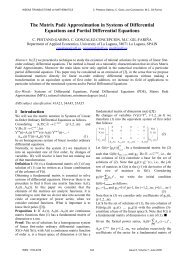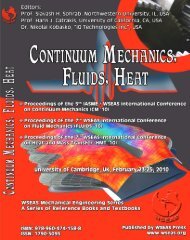Contents - Wseas.us
Contents - Wseas.us
Contents - Wseas.us
You also want an ePaper? Increase the reach of your titles
YUMPU automatically turns print PDFs into web optimized ePapers that Google loves.
Recent Researches in Applied Computers and Computational Science<br />
Plenary Lecture 4<br />
A Safer Future: Reducing the Impacts of Earthquake Disasters through Soft Computing<br />
Professor Silvia Garcia<br />
Group of Geoseismic Soft Computing<br />
Geotechnical Department, Institute of Engineering<br />
National University of Mexico<br />
Mexico<br />
E-mail: sgab@pumas.iingen.unam.mx<br />
Abstract: Each year natural disasters kill tho<strong>us</strong>ands of people and inflict billions of dollars in economic losses. No<br />
nation or community is immune to their damage. In 2010, the Chilean quake would cost the insurance ind<strong>us</strong>try<br />
between 4 and 7 billion dollars and the earthquake’s losses to economy of Chile are estimated at US$15-30 billion.<br />
On 11 March 2011, Japan suffered the worst earthquake in its history (and one of the worst in world history). The<br />
2011 Tohoku earthquake measured produced a tsunami approximately 10 meters (33 feet) high and despite the<br />
warning systems, tho<strong>us</strong>ands were killed by the quake and tsunami. Over 100,000 buildings were damaged with<br />
several towns essentially completely destroyed. Hundreds of aftershocks, including some over 7 MW, continued after<br />
the first earthquake. As a result of the Fuk<strong>us</strong>hima I nuclear accidents that followed the tsunami, attention has been<br />
drawn attention to ongoing concerns over Japanese nuclear seismic design standards.<br />
The scientific and technological advances of the last half century provide unprecedented opportunities for responding<br />
to the urgent need to mitigate the impacts of earthquakes hazards. Good predictions and warnings save lives. Proper<br />
data analysis methods for the extraction of the temporal-frequency-energy distribution of motion recordings (ground<br />
acceleration) can help to explain earthquake phenomena, to understand important seismic issues (source<br />
mechanism, directivity influence, and soil dynamic nonlinearity) and to improve our knowledge of the underlying<br />
physical process the data expose. In this paper some features associated with soft computing for modeling complex<br />
natural systems will be described through a review for some of their successful geoseismic applications. The paper<br />
starts with a brief overview of the structure and operations of the neurofuzzy assessment of dynamic properties and<br />
spatial variation of soft-clays, the neural estimation of site response <strong>us</strong>ing an adaptative characterization of the<br />
seismic time series through the Hilbert-Huang Transform and the nonlinear definition of vibration on soils during<br />
earthquakes <strong>us</strong>ing labels and concepts from Chaos Theory. It is hoped that this work may attract more geotechnical,<br />
seismological and computers engineers to pay better attention to this promising field.<br />
Brief Biography of the Speaker: Prof. Silvia Garcia holds a PhD degree in Geotechnical Engineering, a MEng in<br />
Soil Dynamics and Earthquake Engineering and a BSc in Civil Engineering, her more recent Postdoctoral course was<br />
on Emerging Computing. She has also studied Mathematics and Physics. She is the Head of the Geoseismic Soft<br />
Computing of the Institute of Engineering in the National University of Mexico, Mexico. She is teaching the<br />
postgraduate courses (i) Natural Systems Modeling, running by the National University of Mexico in cooperation with<br />
the Computing Investigation Center of the Polytechnic Institute of Mexico, and (ii) Advances in Geotechnical Designs,<br />
(iii) Soil properties Soft Determination, and (iv) New Technologies in Analysis of Earthquake Data. Her research<br />
interests are in 4D-embankments seismic design, soils engineering systems non-linear analysis, ground motions<br />
monitoring, study and prediction under extreme environments and knowledge-based estimation of static and dynamic<br />
properties of heterogeneo<strong>us</strong> soils. She has >110 publications in highly ranked journals and conference proceedings,<br />
including research articles in collective volumes, chapters in specialized engineering books and citations in civil and<br />
computing engineering fields.<br />
She has participated (and chaired after invitation from the organizers) in prestigio<strong>us</strong> international conferences, such<br />
as those organized periodically by the ECCOMAS, The European Community on Computational Methods in Applied<br />
Sciences, the ISSMG, The International Society for Soil Mechanics and Geotechnical Engineering, IAEE, The<br />
International Association of Earthquake Engineering, and the WSEAS Organizations. She is organizing the Student<br />
and Young Engineers Congresses over the world for the ISSMG running successfully every two years since 2009<br />
within the International Conference of Geotechnical Engineering.<br />
ISBN: 978-1-61804-084-8 16


